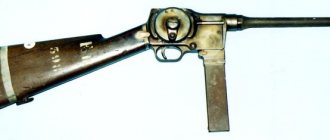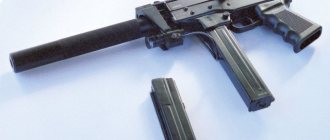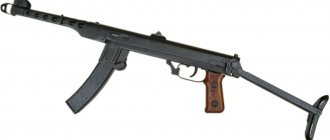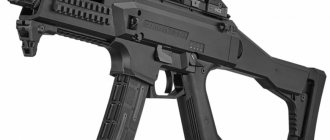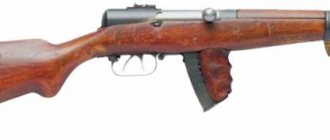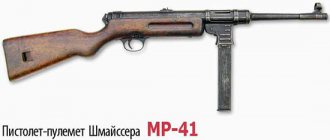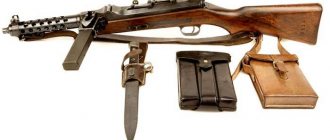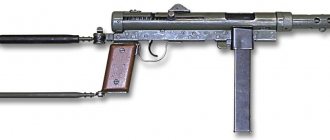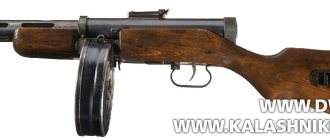Type of automatic firearm
General John T. Thompson holding a Thompson M1921
Pistol - machine gun
, abbreviated as
SMG
, is a magazine-fed, automatic carbine designed to fire pistol cartridges. The term "submachine gun" was coined by John T. Thompson, inventor of the Thompson assault rifle, [1] to describe the design concept as an automatic firearm with noticeably less firepower than a machine gun (hence the prefix "sub"). Since a machine gun must fire rifle rounds to be classified as such, submachine guns are not considered machine guns.
The submachine gun was developed during the First World War (1914–1918) as a close-quarters weapon, primarily for trench raiding. At its peak during World War II (1939–1945), millions of submachine guns were produced for use by both regular troops, underground special forces and partisans. After the war, new types of submachine guns began to appear. [2] However, by the 1980s, the use of SMGs had declined. [2] Today, assault rifles have been largely replaced by submachine guns, [2] which have a more effective range and are capable of penetrating helmets and body armor used by modern infantry. [3] However, submachine guns are still used by military special forces and police close quarters combat (CQB) SWAT teams because they are "pistol-caliber weapons that are easy to control and less likely to penetrate the target." [3]
GIGN, 2016. The soldier on the right holds a Heckler & Koch MP5.
History[edit]
Luger P08 artillery pistol with drum magazine and removable stock.
First World War[edit]
During World War I, Austria-Hungary introduced the world's first automatic pistol: the Steyr Repetierpistole M1912/P16. The Germans also experimented with submachine guns, converting pistols such as the Mauser C96 and Luger P-08 from semi-automatic to full-automatic and adding detachable stocks. Automatic carbine-type weapons firing pistol cartridges were developed in the latter stages of the First World War by Italy, Germany and the United States. Their improved firepower (800-1000RPM) and portability offered an advantage in trench warfare, [4] where most troops were issued bolt-action rifles such as the Gewehr 98 or Lee-Enfield.
Beretta 1918
In 1915, the Kingdom of Italy introduced the Villar-Perosa aircraft machine gun. It fired Glisenti 9 mm pistol caliber cartridges, but was not a true submachine gun, as it was originally designed as a mounted weapon. This odd design was modified into the OVP 1918 carbine-type submachine gun, which then evolved into the 9×19mm Parabellum Beretta Model 1918 after the end of World War I. Both the OVP 1918 and 1918 Beretta were traditional wood stock, 25-round top-feed box magazines and rate of fire 900 rounds per minute.
Bergmann MP 18 was the world's first practical submachine gun
The Germans initially used heavier versions of the P08 pistol with a detachable stock, a larger capacity drum magazine, and a longer barrel. By 1918, Bergmann Waffenfabrik had developed the 9 mm Parabellum MP 18 submachine gun, the first practical submachine gun. This weapon used the same 32-round magazine as the Luger P-08. The MP 18 was used in significant numbers by German ground attack aircraft in infiltration tactics, achieving notable success in the final year of the war. However, this was not enough to prevent the collapse of Germany in November 1918. After World War I, the MP 18 evolved into the MP28/II submachine gun, which included a simple 32-round box magazine, selective fire, and other minor improvements. [5] Although the MP18 had a fairly short service life, it influenced the design of later submachine guns such as the Lanchester, Sten and PPD-40. [6]
Thompson M1921 submachine gun with 100-round drum magazine
The +0.45 ACP Thompson submachine gun was in development around the same time as the Bergman and Beretta. However, the war ended before the prototypes were shipped to Europe. [7] Although it missed its chance to be the first purpose-designed submachine gun to enter service, it became the basis for later weapons and was far more successful than other submachine guns produced during the First World War.
During the interwar period, the "Tommy Gun" or "Chicago Typewriter" became notorious in the US due to its use by the Mafia: the image of James Cagney in pinstripe suits with a Thompsons drum magazine caused some military strategists to shun the weapon. . However, the FBI and other US police forces themselves have shown no reluctance to use and prominently display these weapons. Eventually, the submachine gun was gradually adopted by many military organizations, especially as World War II approached and many countries developed their own designs.
World War II[edit]
Beretta Model 38
Changes in design accelerated during the war, with one of the major trends being the abandonment of complex and well-executed pre-war designs such as the Thompson submachine gun in favor of weapons designed for cheap mass production and easy replacement, such as the M3 Grease Gun.
As described above, the Italians were among the first to develop submachine guns during the First World War. However, they were in no hurry to produce them under Mussolini; The Beretta Model 1938 9mm parabellum was not available in large quantities until 1943. 38 was produced in a series of improved and simplified models, all of which had the same basic layout. The Beretta has two triggers: front for semi-automatic and rear for full-automatic. Most models use a standard wooden stock, although some models were equipped with an MP40-style folding stock and are often mistaken for a German submachine gun. The 38 series was extremely reliable and proved very popular with both Axis and Allied forces (who used captured Berettas).[8] Considered the most successful and effective Italian small arms of World War II.
MP40 Pistol - 9mm Parabellum machine gun from the promotion extended.
In 1939, the Germans introduced the 9mm Parabellum MP38, which was first used during the invasion of Poland in September of that year. However, production of the MP38 was still just beginning, with only a few thousand in service at the time. It proved to be much more practical and effective in close combat than the standard German Kar98K bolt-action rifle. Based on this experience, a simplified and modernized MP40 (commonly and erroneously called Schmeisser) was developed and produced in large numbers; about a million were earned during World War II. The MP40 was lighter than the MP38. It also used more stamped parts, making it faster and cheaper to produce. [9]The MP38 and MP40 were the first submachine guns to use plastic furniture and a practical folding stock, [9] which became the standard for all future submachine gun designs. [9]
Suomi M31 assault rifle with attached 70-round drum magazine, 20-round and 50-round box magazines.
During the Winter War, the heavily outnumbered Finns used the Suomi KP/-31 in large numbers against the Russians with devastating effect. [10] Finnish ski troops became known for emerging from the forest on one side of the road, firing at Soviet columns with machine guns, and disappearing again into the forest on the other side. During the Continuation War, Finnish Sissi patrols often equipped every soldier with a CP/-31. Suomi fired 9mm Parabellum cartridges from a 71-round drum magazine (although it was often loaded with 74 rounds). “This submachine gun showed the world the importance of the submachine gun in modern warfare” [10], which led to the development, adoption and mass production of submachine guns by most armies of the world. The Suomi saw service in combat until the end of the Lapland War, was widely exported [10] and remained in service until the late 1970s.
PPSh-41 with a drum magazine for 71 rounds
In 1940, the Russians introduced the 7.62×25mm PPD-40 and later the easier-to-produce PPSh-41 in response to their experience during the Winter War against Finland. The PPSh drum magazine with 71 rounds is a copy of the Suomi magazine. Later, during the war, they developed an even more mass-produced PPS submachine gun - all fired the same small but powerful Tokarev cartridges. By the end of World War II, the USSR had produced more than 6 million PPSh-41 and 2 million PPS-43. Thus, the Soviet Union could field a huge number of submachine guns against the Wehrmacht, while entire infantry battalions were armed with nothing else. [11] Even in the hands of conscripts with minimal training, the volume of fire produced by massed machine guns could be enormous.
STEN MK II
In 1941, Great Britain adopted the 9 mm Parabellum Lanchester submachine gun. After the evacuation from Dunkirk and due to lack of time for routine research and development of new weapons, it was decided to make a direct copy of the German MP 28. However, this pistol, the Lanchester, proved difficult and expensive to produce. Soon after, a simpler STEN submachine gun was developed, which was much cheaper and faster to manufacture. More than 4 million STEN pistols were produced during World War II. Indeed, the STEN was so cheap and easy to produce that towards the end of World War II, with their economic base nearing crisis, Germany began producing their own copy of the MP 3008. After the war, the British replaced the STEN with the Sterling submachine gun. Britain also used many M1928 Thompson submachine guns during World War II, but the cost of the Thompson was largely what prompted the development of the Sten.
M3 "Grease Gun" on top and M1A1 "Tommy Gun" on bottom
The United States and its allies used the Thompson submachine gun, especially the simplified M1. However, the Thompson was still expensive and slow to produce. Therefore, the US developed the M3 or "Grease Gun" submachine gun in 1942, and then the improved M3A1 in 1944. Although the M3 was no more effective than the Tommy Gun, it was made primarily from stamped parts and welded together, and therefore could be produced much faster and cheaper than the Thompson. Additionally, its much lower rate of fire made it more controllable. It could be configured to fire either .45 ACP or 9mm Luger ammunition. The M3A1 was one of the oldest submachine guns, being produced in the 1960s and serving in the US military into the 1990s.
Owen's pistol, which was officially known as the Owen Automatic Carbine.
The Owen Gun is a 9mm Parabellum Australian submachine gun designed by Evelyn Owen in 1939. The Owen Gun is a simple, highly reliable, open bolt, blowback SMG. It was designed to be fired from the shoulder or hip. It is easily recognizable due to its unconventional appearance, which includes a quick-release barrel and stock, a dual pistol grip, a top-mounted magazine, and an unusual offset right-hand sight. The Owen was the only all-Australian World War II service submachine gun and was used by the Australian Army from 1943 until the mid-1960s when it was replaced by the F1 submachine gun. Only about 45,000 Owens were produced during the war, costing around A$30.
The pistol is a Type 100 machine gun with a bayonet.
While most other countries developed multiple submachine guns during World War II, the Empire of Japan produced only one Type 100 submachine gun, largely based on the German MP28. Like most other small arms created in Imperial Japan, the Type 100 could be equipped with a bayonet. It used the 8x22mm Nambu cartridge, which was about half as weak as the standard 9mm Western Parabellum cartridge. [12] Production of the pistol was even more insufficient: by the end of the war, Japan had produced only about 7,500 [13] Type 100 rifles, while Germany, America, and other countries involved in the war produced over a million of their pistols. SMG's own designs.
Experience in close-range urban warfare led the German military to want a weapon that represented a compromise between the high firing power of a submachine gun and the accuracy of a full-size rifle; after a false start with the FG 42, this led to the development of the StG 44 limited-fire assault rifle, the first weapon to bear that name. In the years following the war, this new format began to gradually replace submachine guns in military use to a large extent. Based on the StG44, the Soviet Union created the AK-47, which is by far the most produced firearm in the world, with over 100 million units produced.
After World War II[edit]
After World War II, “new designs of submachine guns appeared almost every week to replace the admittedly rough and ready designs that appeared during the war. Some (the best of them) survived, but few of them went beyond glossy brochures.” [14] Most of these survivors were cheaper, simpler, and faster than their predecessors. In this form they became widespread.
US Army Swedish K SMG submachine gun: A soldier fires an SMG M/45B during special weapons training.
In 1945, Sweden introduced the 9 mm Parabellum Carl Gustav M/45 submachine gun, a design that borrowed and improved upon many of the design elements of earlier submachine gun models. It has a steel tubular stamped receiver with a butt folding to the side. The M/45 was widely exported and was especially popular with CIA and US Special Forces personnel during the Vietnam War. In US service it was known as the "Swedish-K". In 1966, the Swedish government blocked the sale of firearms to the United States because it supported North Vietnam in the Vietnam War. [15] As a result, the following year Smith & Wesson began production of a clone of the M/45 called the M76.
In 1946, Denmark introduced the Madsen M-46, followed by the improved Madsen M-50 in 1950. These 9mm stamped steel Parabellum submachine guns featured a unique clamshell design, a side-folding stock, and a magazine body safety. The Madsen was widely exported and was particularly popular in Latin America, with variants produced in several countries.
Czechoslovakian Sa vz. 25
In 1948, Czechoslovakia introduced the Sa vz. Episode 23. This 9 mm Parabellum submachine gun introduced several innovations: a progressive trigger for selecting between semi-automatic and full-automatic firing modes, a telescopic bolt that spans the barrel forward, and a vertical grip housing the magazine and trigger. Model vz. The Series 23 was widely exported and particularly popular in Africa and the Middle East, with variants produced in several countries. Model vz. 23 inspired the development of the Uzi submachine gun. [16]
MAT-49 on display
In 1949, France introduced the MAT-49 to replace the French, American, British, German and Italian submachine guns in French service after World War II. The 9mm Parabellum MAT-49 is an inexpensive stamped steel submachine gun with a retractable wire stock, a distinctive folding magazine cover, and a grip safety. This "wildebeest-like design" proved to be an extremely reliable and effective submachine gun and was used by the French well into the 1980s. It has also been widely exported to Africa, Asia and the Middle East.
1950s[edit]
UZI
In 1954, Israel introduced a 9 mm Parabellum open-breech, blowback-action submachine gun called the Uzi (after its designer, Uziel Gal). The Uzi was one of the first weapons to use a telescopic bolt with a magazine housed in the pistol grip for shorter weapons. The Uzi has become the most popular submachine gun in the world, with over 10 million units sold [17], more than any other submachine gun. [18]
Beretta M12S
In 1959, Beretta introduced the Model 12. This 9mm Parabellum submachine gun was a complete breakthrough from previous Beretta designs. [19] This is a small, compact, very well made submachine gun that is one of the first to use a sliding bolt. [19] The M12 was designed for mass production and was made primarily from stamped steel and welded together. [19] It can be identified by its tubular-shaped receiver, dual pistol grip, side-folding stock, and magazine located in front of the trigger guard. The M12 uses the same magazines as the Model 38 series.
1960s[edit]
Heckler & Koch MP5
In the 1960s, Heckler & Koch developed the Parabellum MP5 9 mm submachine gun. The MP5 is based on the G3 rifle and uses the same blowback/roller action control system. This makes the MP5 more accurate than open-bolt submachine guns such as the Uzi. The MP5 is also one of the most widely used submachine guns in the world [20], having been adopted by 40 countries and numerous military, law enforcement, intelligence, and security organizations. [21]
Steyr MPi69
In 1969 Steyr introduced the MPi 69. This 9mm Parabellum open-breech, automatic-breech submachine gun has a sliding bolt and is similar in appearance to the Uzi submachine gun. [22] It has a vertical pistol grip into which the magazine is inserted, a longer horizontal foregrip, and a telescoping wire stock. The receiver is a rectangular shaped stamped steel tube that partially fits within a large plastic housing (resembling the lower receiver) housing the front grip, vertical pistol grip, and fire control group, making the MPi 69 one of the first firearms to feature in which a plastic construction was used. It has a progressive trigger and is also unusual among modern submachine guns in that the MPi 69 is operated by a dual-purpose lever that also serves as a forward sling attachment point. [22]
1970s[edit]
Ingram MAC 10 with suppressor. Note: no log
In the 1970s, extremely compact submachine guns, such as the .45ACP Mac-10 and .380 ACP Mac-11, were developed for use with suppressors or silencers. [23] Although these submachine guns received widespread publicity and were widely used in films and television, they were not widely used by the military or police. [23] These smaller weapons prompted other manufacturers to develop their own compact submachine guns, such as the Micro-UZI and H&K MP5K.
1980s[edit]
The Argentine soldier is armed with a 9 mm Colt submachine gun, which is almost identical to the M16 rifle.
By the 1980s, the demand for new submachine guns was very low and could easily be met by existing manufacturers with existing designs. [2] However, following H&K's lead, other manufacturers began developing submachine guns based on their existing assault rifle models. These new submachine guns had a high degree of commonality of parts with the basic weapons, which alleviated logistical problems.
In 1987, Colt introduced the Colt 9mm submachine gun, based on the M16 rifle. [24] The Colt SMG is a closed-breech, blowback-operated submachine gun with an overall appearance identical to most M16-style rifles. The magazine well is modified using a special adapter that allows the use of smaller 9 mm magazines. The magazines themselves are a copy of the Israeli UZI SMG magazine, modified to fit the Colt and lock the bolt after the last shot. The Colt is widely used by US police and US Marines. [25]
1990s[edit]
Heckler & Koch UMP45 with vertical handguard
In 1998, H&K introduced the last widely available submachine gun, the UMP "Universal Submachine Gun". [26] The UMP is a .40 S&W or .45 ACP closed-breech, blowback-operated submachine gun based on the H&K G36 assault rifle. [27] [28] It has a predominantly polymer construction and was designed as a lighter, cheaper alternative to the MP5. [27] [29] The UMP has a side-folding stock and is available with four different trigger group configurations. [30] It was also designed to accept a wide range of Picatinny rail-mounted accessories [27] [28]
2000s [edit]
Vityaz-SN
In 2004, Izhmash introduced the Vityaz-SN 9 mm Parabellum submachine gun with a closed bolt and straight blowback action. It is based on the AK-74 rifle and offers a high degree of commonality of parts with the AK-74. [31] This is the standard submachine gun for all branches of the Russian military and police. [32] [33]
In 2009, KRISS USA introduced the KRISS Vector family of submachine guns. [34] Futuristic in appearance, the KRISS uses an unconventional delayed blowback system combined with a linear design to reduce perceived recoil and muzzle rise. The KRISS comes in 9mm Parabellum, .45 ACP, .40 S&W, 9×21mm, 10mm Auto and .357 SIG. It also uses standard Glock pistol magazines.
2010s[edit]
By 2010, compact assault rifles and personal protective equipment had replaced submachine guns in most applications. [2] Factors such as the increasing use of body armor and logistical problems combined to limit the appeal of submachine guns. However, submachine guns are still used by police (especially SWAT teams) to engage heavily armed suspects and military special forces units for close combat due to their smaller size, recoil, and muzzle blast. Submachine guns are also amenable to the use of suppressors, especially when loaded with subsonic ammunition. The Sterling and Heckler & Koch MP5 variants were manufactured with integral suppressors.
The place of submachine guns in the Russian army
This humorous sketch was born in the course of behind-the-scenes debates and showdowns on the subject of “where to get it, if you can’t get it?”
Remembering the words of one wise person, the place of domestic PP “is in the same female primary sexual characteristic that begins with “P” and ends with “E” (well, yes, in “Character E”).
In the traditions of the Russian army , when asked to give something quick-firing and small-sized, the person asking for it is usually given either an APS (if they love and appreciate it, and are ready to take it from the heart), or an AKSU (if you don’t want to offend), or something completely precious like 9A -91 (though with a face like “if you lose it, hang yourself right away”). It is clear that of all of the above the APS a submachine gun with a stretch) (no wonder!? You can also stretch a condom onto a globe). True, few people know how to competently deal with this fool anymore.
But we don’t really have PP in the classical sense in our army. In Russia, for some reason, the opinion has become stronger that the PP is a purely police weapon . In principle, after the regular stories of the 90s, when an employee shot with an AKSU at a criminal, and with him laid a completely stranger's housewife, a basket, a picture, a cardboard and a small dog on the cold asphalt - these were by no means such a rare occurrence.
However, if we remember the level of shooting training of our valiant police officers, then giving them weapons with such a range and destructive power was generally an extremely stupid decision. On the other hand, what else could they have been given in those years when a trip to a household dismantling could result in a 7.62 through the door from an old, but very serviceable AK-47 ? And this is not to mention the fact that the valiant Russian lads compared favorably with the police in terms of weapons. However, time passed, and finally the Ministry of Internal Affairs removed from the depths of its SOBR and OMON troops , who really knew how to use automatic weapons with minimal risk to themselves and others. And it became finally possible to take away the good old AKSU from the unfortunate police officers, who were given these same machine guns so that the bandits would their pistols .
The situation is simple - the police took away the machine guns, but the fear remained. Still, the police for the most part are Russian people who want everything to be simple. Repeatedly press the trigger, and even if he pressed it once, his opponent would be bombarded with petty but weighty arguments.
And everything would be fine, because the demands of the police can be fulfilled for decades, but in the end they will survive. How suddenly Chechnya happened. Chechnya just happened for the army in our country. Like snow in winter, like floods in spring, that is, completely suddenly and unexpectedly.
About AKSU and the difficult legacy of the Soviet past
All previous concepts of the existence of the army, taken from the damned Soviet past, provided only for work in operational spaces. And where there is a lot of space, compactness is not needed. And in the end, the longer the barrel, the deeper it is able to penetrate into the anus of a NATO aggressor, and a short barrel is unnecessary humanism and philanthropy, inapplicable to the enemy.
And who would have thought that the cleansing of an ordinary Grozny Khrushchev building was somehow different from a victorious march along the Champs-Elysees or clearing some Hyde Park from the capitalist infection. As life has shown, it is different. And very strongly. And this is where the questions from the military began.
The question was simple - don’t you have expensive construction kits, something powerful enough, compact and fast-firing ?
First of all, those who asked were given the already familiar AKSU , which quite suddenly (although this vile quality was known since Afghanistan), reminded that it was not just a small and proud machine gun, but also a generator of a scarlet flower. What is a scarlet flower? Everything is simple here, fire from the AKSU in the classic position, and you will understand everything - the flash when fired blinds the shooter.
And he successfully manages to do this during the day. What if you need to shoot at night? What if the shooter is also wearing a night vision device? After one shot, you can completely forget about shooting for 2-3 minutes while you still blink... Well, in addition, three shooters with AKSU at night could illuminate the position so that the fourth could calmly read a book at that time.
Moreover, these were those times when the thought that it was possible to replace the DTK (Muzzle Brake-Compensator) was not even in the minds of Russia.
If there are smart and enlightened people in the room who will mention the magical and divine complex “Canary”, then I will ask in response: “How many of that “Canary” were there in total? The treasured “bird” was not enough. So much so that even in the second campaign, the accidental exposure of this beauty led to long and tedious runs from those suffering and those who wanted it.
And users reached out with unwashed hands to the designers. And the designers, looking at the gentle and kind eyes of the users, suddenly realized that the AKSU , although short, would penetrate shallowly, but no one would remove the front sight, and therefore the sensations awaiting them would be both unforgettable and painful. Naturally, within the framework of the program “let’s protect the science-intensive anus from the encroachments of the dirty military,” they immediately tried to give out at least something, just to get rid of it.
Stillborn children of the gloomy Russian genius
The first attempt at “fuck off” was “Cedar”. And here the designers had a problem and broke the template. It turns out (this is a twist) that weapons that have police functions are a little less suitable for the army than absolutely nothing. And the main ambush lies in the ammunition. Which in the Kedr software is used from the well-known pistol . That is 9x18. And he, I’ll tell you, even body armor from time to time. That is, the situation when a Wahhabi, in whom half a magazine from “Cedar” was loaded, wheezing with bruised lungs and crunching cracked ribs, planted a couple of bullets in the back of a nimble shooter, began to become sad and constant.
The military again stretched out its dirty paws to the clean anuses of the designers, although the eyes were no longer entirely kind. The situation was further aggravated by the fact that in the first campaign (and at the beginning of the second too) a body armor was a luxury item. And for the militants, it’s a painful detail of everyday life. And despite the once popular cries that the PM quilted jacket does not penetrate, the Borz PP, designed by valiant Armenian gunsmiths and fueled with Chechen nuggets, fired with the same PMv cartridges, the army quilted jacket was stamped with a bang. It was only later, when the bulletproof vest became a normal and standard element of the uniform, the Borz practically disappeared from use, and in those days... Well, oh well, the story is sad and sad.
Naturally, attempts to protect their asses from painful ruptures became much more intense. Designers began to give birth much more often. Sometimes we got something sane like the PP-19 Bison-1/2, in which the issue of low ammunition power was solved by dramatically increasing the magazine . The auger could hold as many as 64 rounds, but had a significant drawback. Considering that the fighting took place not on training grounds and in the uncomfortable conditions of the southern countries, but in the shitholes and muddy areas traditional for Mother’s homeland, the reliability of the store and protection from these very shitty shitties and muddy areas were below any criticism at all. And the process of equipping a store, without special gadgets, could plunge a seasoned masochist into horror, not to mention ordinary, normal people.
There was an attempt to adapt the good old AKSU for the PM cartridge. Project PP-19-01 “Vityaz”. It turned out funny but nothing more. For some reason, the designers did not think that the machine gun, originally designed for a 30-round magazine with machine gun ammunition, would lose a little in balance and controllability when switching it to pistol cartridges. Plus, in those years, the quality at Izhmash dropped to such a level that the level of accuracy of the PP (despite the fact that the requirements for them were already quite low) dropped to “somewhere there,” which did not suit the customer a little.
No, in the end, of course, the project was completed and brought to an acceptable form and content (which was expressed in translation into Parabellum 9x19), but for some reason the TsSN prudently purchased German variations on the HK MP5 theme, took a couple of dozen samples and said “no thanks.” So “Vityaz” eventually somehow spread throughout the structures of the Ministry of Internal Affairs, which were already happy about at least something. Well, compared to the rest of the fucked up stuff, it looks pretty decent, both in terms of performance characteristics and capabilities.
Another “bastard” PP-2000 (designed by Gryazev and Shipunov, after which people, by inertia, were suspicious of the quite decent GSh-18), was not saved even by the Parabellum cartridge. Everything was perfect there, ergonomics bordering on design, plastic that resembled toothbrushes, and a wonderful habit of shooting anywhere except in the right place. No, of course there were nuggets that could rein in this metal-plastic structure , but it required such expenses... Moreover, the quality was approximately at the level of the same plinth, that the project did not take off and died safely, only sometimes emerging from oblivion and frightening people with its appearance.
What's the end result?
In the end, it was not the gunsmiths who found a way out of the situation, but the patrons. Who finally remembered the melancholy howl of the Ministry of Internal Affairs, “Can we have the same bullet, but the darn shot hurts more painfully in the forehead?” and they issued the 9x18 Ultra , which was still far from parabellum, of course, but it was already possible to stay away from its younger brother and not embarrass itself.
Immediately the situation became a little better, 9x18 Ultra confidently stamped third-class body armor army helmet , and generally began to show that the domestic pistol cartridge is suitable not only for shooting and arming a policeman, but is also quite capable of taking part in adults showdowns. In addition, it did not require a radically new weapon ; it was enough to modernize the old one. And everything would be fine, when suddenly...
The second Chechen war has ended. During which everyone no longer gave a damn about submachine guns , everyone got used to destroying buildings with the enemy from the outside. And the entrances into the premises had already been worked out so much that a long barrel or a short one no longer mattered.
So it turned out that we did not have time to develop submachine guns The military overcame the period of serious necessity, which the designers bravely screwed up, with their own strength and long guns. And submachine guns actually remained a police toy, and a requirement for anti-terrorism units, which were already very specially trained, and taught their homeland not to skimp on them (and therefore they switched en masse to the MP5PDW-SD6/7 to the envy of their more authorized colleagues). And the idea of a submachine gun once again failed to capture the domestic masses.
No, of course there are successful developments like the same SR-2 “Veresk ” , and they have made all sorts of funny toys for various special cartridges. But in a way that would be massive, simple and clear - we still don’t have that. The crews of armored vehicles and helicopter/airplane pilots are still equipped with the good old AKSU , and prefer not to buzz.
That's bullshit like that.
That is, the answer to the question “does the Russian army need PP” remained at the level of “Do the Russians want war”...
Personal defense weapons[edit]
FN P90
The Personal Defense Weapon (PDW), developed in the late 1980s, is touted as a further development of the submachine gun. The PDW was created in response to a NATO request for a replacement for the 9x19mm Parabellum submachine guns. The PDW is a compact automatic weapon that uses specially designed rifle-style cartridges to fire armor-piercing bullets and is light enough for easy use by non-combatant and support troops, as well as an effective close-in weapon for special forces and countermeasures forces. -terrorist groups. [35] [36]
Introduced in 1991, the FN P90 features a bullpup design with a futuristic appearance. It has a 50-round magazine positioned horizontally above the barrel, an integrated reflex sight, and fully ambidextrous controls. [37] A simple blowback automatic weapon, it was designed to fire the proprietary 5.7×28mm FN cartridge, which can penetrate soft body armor. [35] [36] The P90 was designed to be no more than the width of an average person's shoulders so that it could be easily carried and maneuvered in confined spaces, such as inside an infantry fighting vehicle. [37] The P90 is currently in service with the armed forces and police of more than 40 countries. [38]
The Heckler & Koch MP7, introduced in 2001, is a direct competitor to the FN P90. This is a more traditional design, using the short-stroke gas system found in the H&K G36 and HK416 assault rifles, instead of the blowback system traditionally found in submachine guns. [39] The MP7 uses 20-, 30-, and 40-round box magazines and fires proprietary 4.6×30mm ammunition that can penetrate soft body armor. Due to the heavy use of polymers in its construction, the MP7 is much lighter than older SMG models, weighing only 1.2 kg (2.65 lb) with an empty 20-round magazine. The MP7 is currently in service with the armed forces and police of more than 20 countries.
Submachine guns: the underrated weapon of the First World War
Historically, the first automatic weapon chambered for a pistol cartridge appeared at the beginning of the First World War, in 1915. But from a tactical point of view, this weapon (the double-barreled Italian Villar-Perosa submachine gun) was more of a machine gun for close combat, that is, a group support weapon, rather than an individual infantry weapon.
The first full-fledged submachine gun in the modern sense was the Bergmann / Schmeisser MP.18, designed by Louis Schmeisser. Developed based on the experience of fighting in the trenches of the First World War, this model managed to reach the German troops before the end of hostilities. However, most military experts in the leading countries of the world underestimated the role of submachine guns as infantry weapons.
Finnish submachine gun "Suomi"
Often they were considered either an auxiliary weapon, or even a purely police weapon, intended to combat riots. However, in the twenties and thirties, research and development work was carried out in the field of submachine guns in most industrial countries, including the USSR. At the same time, a number of Western arms manufacturers were actively working for export, selling their submachine guns not so much to their own armies as to the countries of Latin America, Africa and Asia.
The reconsideration of the role of submachine guns as military weapons began after studying the Chaco War in the mid-thirties. The experience of the Spanish Civil War spurred developments in the field of submachine guns in the heavily militarized Hitler's Germany, and the USSR came to its senses only after the Red Army began to suffer serious losses from the fire of Finnish machine gunners armed with Suomi submachine guns during the Winter War of 1940.
Name [edit]
There are some inconsistencies in the classification of submachine guns. [40] British Commonwealth sources often refer to SMGs as "automatic carbines". [40] [41] Other sources call SMGs "submachine guns" because they fire pistol-caliber ammunition, such as the MP-40 and MP5, where "MP" stands for Maschinenpistole
("Submachine gun" in German, but cognate with the English term "submachine gun"). [42] However, the term "submachine gun" is also used to describe pistol-style firearms capable of full-automatic or burst fire, [43] such as the Stechkin, Beretta 93R and H&K VP70. Additionally, personal defense weapons such as the FN P90 and H&K MP7 are often referred to as submachine guns. [40] Additionally, some compact assault rifles, such as the Colt XM177 and HK53, have historically been called assault rifles as they served in the latter's role. [44]
World War II: triumph of the submachine gun
The Second World War marked the peak of the development of submachine guns as army weapons. During the war, such submachine guns as the Soviet PPSh-41, PPS-43, German MP-40, and British “Stan” were developed and produced in millions of copies.
However, by the middle of the war, a new type of weapon had emerged, which eventually replaced the submachine gun as the main weapon of the infantry - the machine gun, otherwise known as the assault rifle ( sturmgewehr
-German,
assault rifle
-English).
As a matter of fact, machine guns were developed as more universal substitutes for submachine guns, having a greater effective firing range with comparable weight and dimensions. The Armed Forces of the USSR were the first to abandon submachine guns in the army - already in 1949, the Kalashnikov assault rifle and the Simonov self-loading carbine, designed not for a pistol, but for an intermediate cartridge, were adopted.
Soviet submachine gun PPS-43
Links[edit]
- "The Thompson Submachine Gun: Shooting a 20th Century Icon." — Free online library".
- ^ abcde Military small arms of the twentieth century. Ian Hogg and John Weeks. Krause Publications. 2000. P. 93.
- ^ ab David Crane (December 11, 2011). Submachine Guns (SMGs): Superior to today's Short Barrel Rifles (SBRs)/Sub-Carbines or still a viable Close Quarters Combat/Close Quarters Combat (CQB/CQC) tool? Protection overview.
- Curley, Robert, ed. (2009). The British Guide to the Inventions That Changed the Modern World (First ed.). Rosen Publishing Group. pp. 291–292. ISBN 978-1-61530-064-8.
- Military small arms of the 20th century. 7th edition. Ian W. Hogg and John S. Weeks. Krause Publications. 2000. p. 116
- McNab, Chris (2015). The World's Largest Small Arms: An Illustrated History
. paragraph 61. - Frank Iannamico, American Thunder: Military Pistol - Thompson 1928, 1928A1, M1, M1A1
, Moose Lake Publishing, 2000. - Jump up
↑ Dunlap, Roy F., Ordnance Went Up Front, Samworth Press, (1948), p. 58 - ^ abc Military small arms of the 20th century. 7th edition. Ian W. Hogg and John S. Weeks. Krause Publications. 2000. pp. 118–120.
- ^ abc army. https://world.guns.ru/smg/fi/suomi-m31-e.html
- ↑
Bishop, Chris (2002). Encyclopedia of weapons of the Great Patriotic War. New York: MetroBooks. ISBN 978-1-58663-762-0. Retrieved October 19, 2014. - Henrotin, Gerard (2010). Description of the Nambu Type 14 pistol
. H.L. Publishing. clause 5. - Miller, David (2007). Soldiers of World War II: Uniforms, Equipment and Weapons. Soldiers of the Second World War. 1
. Stackpole Books. p. 279. ISBN 978-0-8117-0277-5. - Military small arms of the 20th century. 7th edition. Ian W. Hogg and John S. Weeks. Krause Publications. 2000. pp. 93–94.
- "Why did Sweden support the Viet Cong?" . YouTube
. - Hogg, Ian W. (1979). Weapons and how they work. New York: Everest House. paragraph 157. ISBN 0-89696-023-4.
- McManners, Hugh (2003). Absolute special forces. New York: DK Publishing. paragraph 157. ISBN 0-7894-9973-8. OCLC 53221575.
- Hackathorn, Ken (1995). "Using Ultrasound." Military firearms
.
Soldier of fortune. 3
(1): 18–23. - ^ abc Military small arms of the 20th century. 7th edition. Ian W. Hogg and John S. Weeks. Krause Publications. 2000. pp. 138–139.
- Jump up
↑ Hogg, Ian (2002).
Jane's Gun Recognition Guide
. Jane Information Group. ISBN 0-00-712760-X. - Tilstra, Russell S. (2012). Small arms for urban combat. USA: McFarland. paragraph 42. ISBN 978-0-7864-6523-1. Archived from the original on 2012-05-09.
- ^ ab Military small arms of the 20th century. 7th edition. Ian W. Hogg and John S. Weeks. Krause Publications. 2000. pp. 97–98.
- ^ ab Military small arms of the 20th century. 7th edition. Ian W. Hogg and John S. Weeks. Krause Publications. 2000. p. 166
- "Archival copy". Archived from the original on 2003-05-18. Retrieved November 7, 2016.CS1 maint: archived copy as title (link)
- Military small arms of the 20th century. Ian Hogg and John Weeks. Krause Publications. 2000. 167 p.
- "Heckler & Koch - band website". Heckler-koch.com. Retrieved June 26, 2009.
- ^ abc Cutshaw, Charles Q (2011). 21st Century Tactical Small Arms: The Complete Guide to Small Arms from Around the World. Iola, WI: Gun Digest Books. item 156. ISBN. 978-1-4402-2709-7.
- ^ ab Jane's Gun Recognition Guide. Ian Hogg and Terry Gander. Published by HaperCollins. 2005. p. 192
- Dockery, Kevin (2007). Weapons of the future. New York: Penguin Group USA. pp. 383–385. ISBN 978-1-101-20618-8.
- Andrius Genys (2010). Submachine guns and assault rifles. Military-Today.com
. Andrius Genis. clause 2. - https://web.archive.org/web/20111109005400/https://www.izhmash.ru/rus/product/vityaz.shtml Product page of Izhmash Vityaz SMG
- “New weapons for Russian cops - so what? - In the shadow of Moscow." In the shadow of Moscow
. Retrieved October 7, 2014. - “Historical information PP-19-01” Vityaz “/” Vityaz-SN “- submachine gun”.
- "Products" . KRISS Arms. Archived from the original on January 20, 2013. Retrieved November 30, 2012.
- ^ ab Miller, David (2001). An Illustrated Guide to 20th Century Implements
. London: ISBN Salamander Books Ltd. 9781840652451. - ^ ab Oliver, David (2007). "In the Line of Fire". Global Defense Review. Archived from the original on October 16, 2006. Retrieved October 19, 2009.
- ^ ab Kevin, Dockery (2007). Weapons of the future. New York: Berkeley Trade. ISBN 9780425217504.
- Tyrance, Ivars (2009). "Proceedings of the conference on defense research and technology in the Baltic countries 2009." Military Review: Scientific Journal on Security and Defense (ISSN 1407-1746), Nr. 3/4 (132/133), p.103.
- Cutshaw, Charles W. (2003). "Heckler & Koch's cutting-edge G36C and MP7 PDW compacts: when less is more". Guns Magazine
. Archived from the original on 2012-07-08. - ^ abc Military small arms of the 20th century. 7th edition. Ian W. Hogg and John S. Weeks. Krause Publications. 2000. pp. 93–94.
- Stan Machine Carbine, Peter Laidler & R Blake Stevens, Collector Grade Publications, Canada; 1st edition (December 2000)
- Military small arms of the 20th century. 7th edition. Ian W. Hogg and John S. Weeks. Krause Publications. 2000. pp. 93–94 and 116–125.
- James Smith Wallace. Chemical Analysis of Firearms, Ammunition and Firearm Residues
. CRC Press. 2008. p. xxiii - Military small arms of the 20th century. 7th edition. Ian W. Hogg and John S. Weeks. Krause Publications. 2000. pp. 125 and 166–167.
